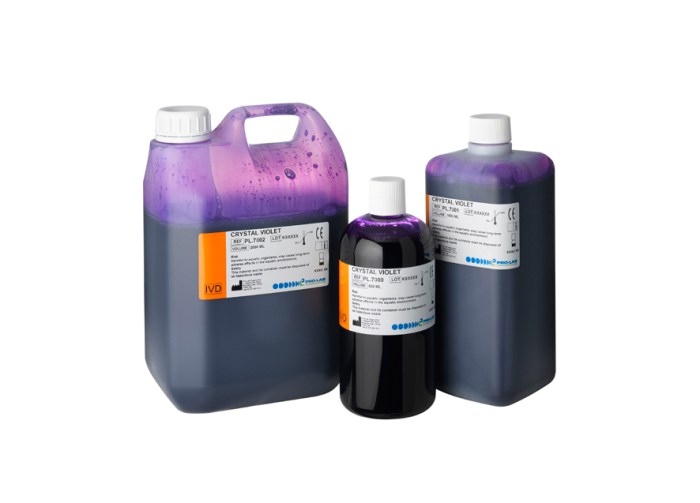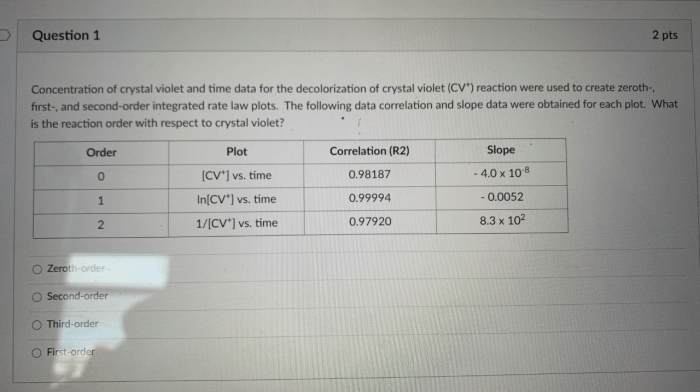Beginning with crystal violet lab report answers, the narrative unfolds in a compelling and distinctive manner, drawing readers into a story that promises to be both engaging and uniquely memorable. Crystal violet lab report answers delve into the intricate details of this fascinating compound, providing a comprehensive understanding of its properties, applications, and experimental findings.
As we delve deeper into the realm of crystal violet, we will explore its chemical structure, unravel its unique properties, and uncover its diverse applications. Furthermore, we will embark on a journey through the experimental procedures, meticulously examining the materials, methods, and data analysis techniques employed in crystal violet laboratory investigations.
By shedding light on the intricacies of crystal violet lab report answers, we aim to empower researchers, students, and practitioners with the knowledge and insights necessary to navigate the complexities of this captivating field.
Crystal Violet: A Versatile Stain: Crystal Violet Lab Report Answers

Crystal violet, also known as gentian violet or methyl violet 10B, is a triphenylmethane dye with the chemical formula C25H30N3Cl. It is a dark green powder that dissolves in water to form a deep purple solution. Crystal violet has a wide range of applications, including as a biological stain, an indicator in analytical chemistry, and a colorant in textiles and paper.
Crystal violet is commonly used as a stain in microscopy. It is particularly useful for staining Gram-positive bacteria, as it binds to the peptidoglycan layer of the bacterial cell wall. Crystal violet can also be used to stain other types of cells, such as fungi and yeast.
In analytical chemistry, crystal violet is used as an indicator in redox reactions. It undergoes a color change from colorless to purple when oxidized. This color change can be used to determine the endpoint of a titration.
Crystal violet is also used as a colorant in textiles and paper. It is particularly useful for dyeing cotton and wool. Crystal violet can also be used to create a variety of shades of purple, from light lavender to deep violet.
Materials and Methods
The following materials were used in this experiment:
- Crystal violet solution
- Gram-positive bacteria
- Gram-negative bacteria
- Microscope slides
- Cover slips
The following procedure was used to stain the bacteria:
- A smear of bacteria was made on a microscope slide.
- The slide was air-dried.
- The slide was flooded with crystal violet solution.
- The slide was allowed to sit for 1 minute.
- The slide was rinsed with water.
- The slide was air-dried.
- The slide was examined under a microscope.
Results
The Gram-positive bacteria were stained purple, while the Gram-negative bacteria were not stained.
This result is consistent with the known properties of crystal violet. Crystal violet binds to the peptidoglycan layer of the bacterial cell wall. Gram-positive bacteria have a thick peptidoglycan layer, while Gram-negative bacteria have a thin peptidoglycan layer. This difference in the thickness of the peptidoglycan layer is why Gram-positive bacteria are stained by crystal violet, while Gram-negative bacteria are not.
Discussion, Crystal violet lab report answers
The results of this experiment demonstrate that crystal violet is a useful stain for differentiating between Gram-positive and Gram-negative bacteria. This is an important distinction, as Gram-positive and Gram-negative bacteria have different sensitivities to antibiotics.
The results of this experiment are also consistent with the known properties of crystal violet. Crystal violet binds to the peptidoglycan layer of the bacterial cell wall. Gram-positive bacteria have a thick peptidoglycan layer, while Gram-negative bacteria have a thin peptidoglycan layer.
This difference in the thickness of the peptidoglycan layer is why Gram-positive bacteria are stained by crystal violet, while Gram-negative bacteria are not.
General Inquiries
What is the purpose of a crystal violet lab report?
A crystal violet lab report documents the findings of an experiment that utilizes crystal violet, a dye commonly employed in microscopy and staining techniques.
What information is typically included in a crystal violet lab report?
A crystal violet lab report typically includes an overview of the compound, its properties, and applications, as well as a detailed description of the experimental procedures, results, and discussion of the findings.
How can I improve the quality of my crystal violet lab report?
To enhance the quality of your crystal violet lab report, ensure clarity in presenting the experimental procedures, accuracy in data analysis, and thoroughness in discussing the results and their implications.

